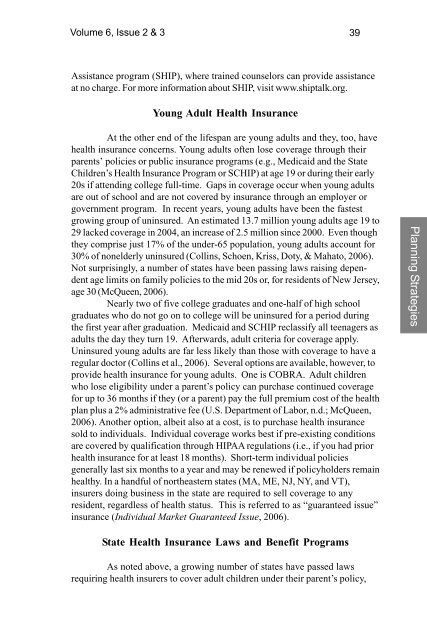3433-vol. 6 issue 2-3.pmd - iarfc
3433-vol. 6 issue 2-3.pmd - iarfc
3433-vol. 6 issue 2-3.pmd - iarfc
Create successful ePaper yourself
Turn your PDF publications into a flip-book with our unique Google optimized e-Paper software.
Volume 6, Issue 2 & 3 39<br />
Assistance program (SHIP), where trained counselors can provide assistance<br />
at no charge. For more information about SHIP, visit www.shiptalk.org.<br />
Young Adult Health Insurance<br />
At the other end of the lifespan are young adults and they, too, have<br />
health insurance concerns. Young adults often lose coverage through their<br />
parents’ policies or public insurance programs (e.g., Medicaid and the State<br />
Children’s Health Insurance Program or SCHIP) at age 19 or during their early<br />
20s if attending college full-time. Gaps in coverage occur when young adults<br />
are out of school and are not covered by insurance through an employer or<br />
government program. In recent years, young adults have been the fastest<br />
growing group of uninsured. An estimated 13.7 million young adults age 19 to<br />
29 lacked coverage in 2004, an increase of 2.5 million since 2000. Even though<br />
they comprise just 17% of the under-65 population, young adults account for<br />
30% of nonelderly uninsured (Collins, Schoen, Kriss, Doty, & Mahato, 2006).<br />
Not surprisingly, a number of states have been passing laws raising dependent<br />
age limits on family policies to the mid 20s or, for residents of New Jersey,<br />
age 30 (McQueen, 2006).<br />
Nearly two of five college graduates and one-half of high school<br />
graduates who do not go on to college will be uninsured for a period during<br />
the first year after graduation. Medicaid and SCHIP reclassify all teenagers as<br />
adults the day they turn 19. Afterwards, adult criteria for coverage apply.<br />
Uninsured young adults are far less likely than those with coverage to have a<br />
regular doctor (Collins et al., 2006). Several options are available, however, to<br />
provide health insurance for young adults. One is COBRA. Adult children<br />
who lose eligibility under a parent’s policy can purchase continued coverage<br />
for up to 36 months if they (or a parent) pay the full premium cost of the health<br />
plan plus a 2% administrative fee (U.S. Department of Labor, n.d.; McQueen,<br />
2006). Another option, albeit also at a cost, is to purchase health insurance<br />
sold to individuals. Individual coverage works best if pre-existing conditions<br />
are covered by qualification through HIPAA regulations (i.e., if you had prior<br />
health insurance for at least 18 months). Short-term individual policies<br />
generally last six months to a year and may be renewed if policyholders remain<br />
healthy. In a handful of northeastern states (MA, ME, NJ, NY, and VT),<br />
insurers doing business in the state are required to sell coverage to any<br />
resident, regardless of health status. This is referred to as “guaranteed <strong>issue</strong>”<br />
insurance (Individual Market Guaranteed Issue, 2006).<br />
Planning Strategies<br />
State Health Insurance Laws and Benefit Programs<br />
As noted above, a growing number of states have passed laws<br />
requiring health insurers to cover adult children under their parent’s policy,
















